A WALL WILL NEVER STOP A BUTTERFLY
When I was a kid, the word “wetback” had negative connotations, but I don’t remember it being considered particularly hateful. My mother even used it to describe herself. I think its relative mildness was directly connected to the widespread, pragmatic acceptance of a necessary system of employment. People south of the border needed work, and southwestern states in the U.S.A. needed workers. This is not to minimize the danger, exploitation, and often horrific working conditions immigrants found — particularly in ranching and agriculture. It is only to say that those who nursed fantasies about locking down the border were a fringe element.
As farm workers began demanding to be treated with basic fairness, and as some alarmed whites began to notice multiculturalism creeping up on them, the term has become most common as a deliberate racist slur, both to the anti-immigrant fanatics who use it, and to the objects of their irrational hatred. It is the one thing both sides can agree on: Being called a “wetback” or a “wet” is meant to be demeaning and dehumanizing. However, as a bubble-bound snowflake of a libtard, apparently hellbent on destroying American sovereignty, I have not heard the word applied to undocumented workers by anyone I know personally for years, decades even.
In Culture Clash’s Bordertown Now at the Pasadena Playhouse, it is a jolt to hear a camo-clad Arizona border warrior, armed with an automatic weapon, jocularly and casually using both terms repeatedly. At gunpoint, he forces two Latinos to their knees, refusing to believe their assertions (proclaimed in unaccented English) that they are U.S. citizens, well-meaning theater documentarians, there to interview people on both sides of the border wars. It takes him an unconscionably long time to stand down. Then he gets curious about their project, demanding they video him for their “movie.” (It is a running joke that most of the documentary subjects are oblivious to the value or even the existence of theater.)
On camera, the man insists his crusade is about protecting the children, from M-13, and from brown people in general. Even the Dreamers are all potential M-13 recruits. Amid moments of political humor and absurdist dance breaks (at the mention of ICE, the documentarians do hip hop moves to Vanilla Ice) the three men take baby steps to finding some common ground. Later in the show, the characters return, and take a giant stride toward viewing one another with empathy, if continued wariness.
This sense of hopefulness is at the heart of what Culture Clash intends. They have been turning documentary interviews into vibrant theatrical experiences for twenty years now and are revisiting the satirical landscape of their late ’˜90s project, Bordertown, in a series of vignettes set at various locations at or near the Sonoran Desert on the American side. It is a culturally significant experience. It is also a very funny and often unexpectedly sweet show that leaves the audience feeling open to finding a shared sense of humanity. Turning on the news in the car radio on the way home, though, is a quick reminder of how perilous and delicate any such journey will be.
Richard Montoya, Ric Salinas, and Herbert Sigüenza are Culture Clash, working with guest artist Sabina Zúñiga Varela and director Diane Rodriguez. It is a fast-paced 90 minutes of real-life personal stories, deftly dramatized with a sprinkling of music, bits of dance, jokes, and education. The names of African Americans murdered by police are juxtaposed with Latinos killed by border agents and vigilantes, or as they die of heatstroke or thirst, made all the more probable by the armed border warriors who pour out the bottles of water left by well-meaning Samaritans. In the well-observed comedy of two Salvadorans, we learn about the origins of M-13 — its roots in Los Angeles, spurred on by hostile deportation policies and American support for a series of tinpot dictators in El Salvador.
The two characters who stand out the most for me are Julie, a young woman in a safe house in Nogales, waiting for an opportunity to cross, and the infamous former felon, Sheriff Joe Arpaio.
Julie is anxious to return to her young son in Arizona, worried about affording an EpiPen for him, and scared that while trying to cross the border she might be shot, raped, deported, or die. She is also a techno music-loving former professor who dreams of marrying another woman. Ms. Varela beautifully brings Julie to life. She is self-mocking but tender, and profane yet mindful. Julie imagines an all-Latina workforce creating the border wall, the women making it beautiful, covering it with murals of monarch butterflies as they build secret tunnels underneath. She doubts a wall will make a difference in the end. The U.S. government will never be able to stop butterflies from crossing above it.
Montoya goes for broke as Sheriff Arpaio, reaching depths that recall Roy Cohn in Angels in America. Arpaio is an odious boor who is never boring, and as he grows drunker and more emotionally inarticulate, he reveals himself as a hot mess, torn between seeing himself as a defeated martyr and an untouchable winner. I have no idea whether Culture Clash took much dramatic license in creating the weird details of Sheriff Joe’s life in his man cave. He stumbles around pouring endless glasses of whiskey, sorting through beloved old LPs, and fondling a treasured gift from the Arizona chapter of the NRA, the actual machine gun used to gun down John Dillinger. It all feels real to me, depressingly small and ultimately tragic in the way of Willy Loman. He may never quite realize how petty and ugly he is, but self-awareness lurks at the edges, a visitor as unwelcome as any ”illegal.”
Scenic designer Efren Delgadillio, Jr., sound designers Montoya and Adam Phalen, lighting designer Lap Chi Chu, and projection designer Yee Eun Nam effectively create an immersive multimedia world. Rodriguez keeps things squarely out of the world of sketch comedy, creating vibrant, well-observed scenes of connection.
There is a moment of funny transcendence near the end. With an affectionate nod to Angels in America, a projected image of the Virgin Mary morphs into a real-life angel. She cracks some jokes, makes some wise observations, and leaves you wondering whether you might laugh or cry. Culture Clash likely hopes you do both.
photos by Philicia Endelman
Bordertown Now
Pasadena Playhouse, 39 S. El Molino Ave. in Pasadena
Wed-Fri at 8; Sat at 2 & 8; Sun at 2
ends on June 24, 2018
for tickets, call 626.356.7529 or visit Playhouse
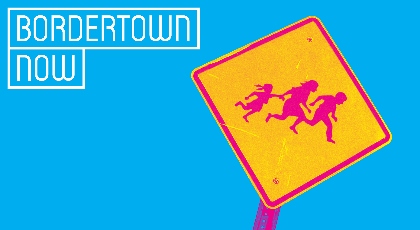
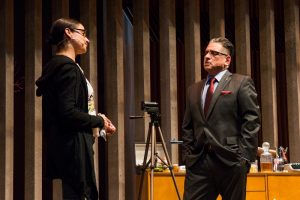
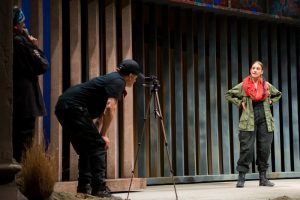
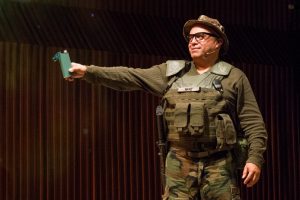
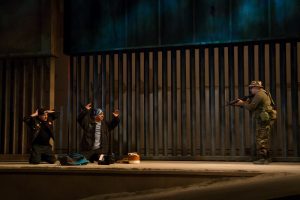
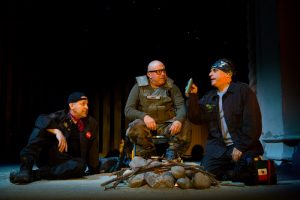
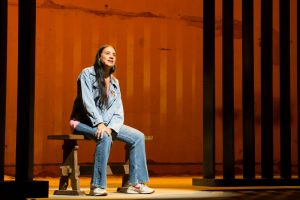
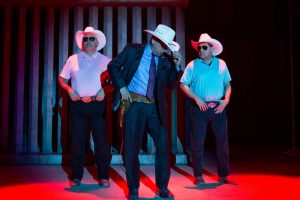


{ 4 comments… read them below or add one }
Hi Samuel:
While I designed the costumes for Bordertown Now, I would like to speak on behalf of Yee Eun Nam who was the projection designer on this show. When you mention that the designers “create an immersive multimedia world” you should not leave her out, as she created much of that world as well.
Thank you.
I am SO glad you reached out. That was my mistake.
Projection designer Yee Eun Nam’s name has been added to the review, Jenny. Thanks.
Thank you